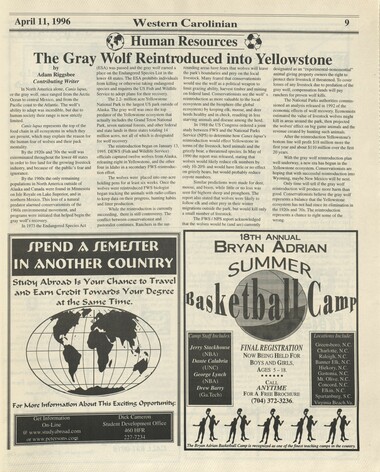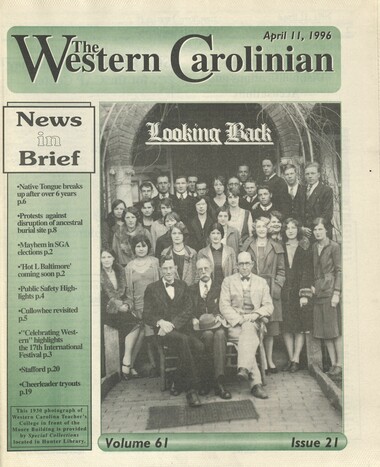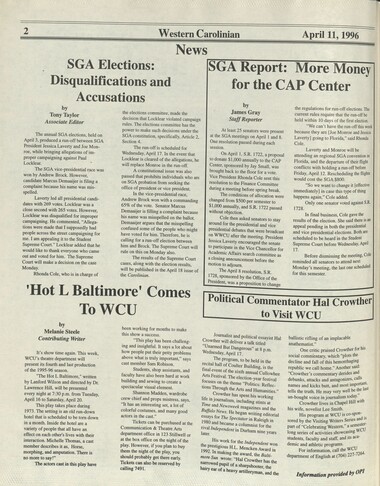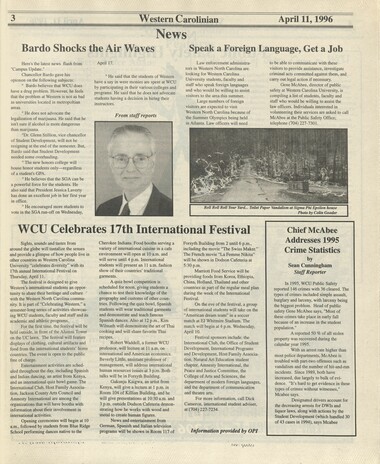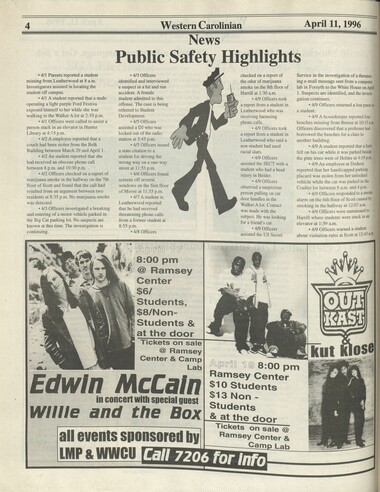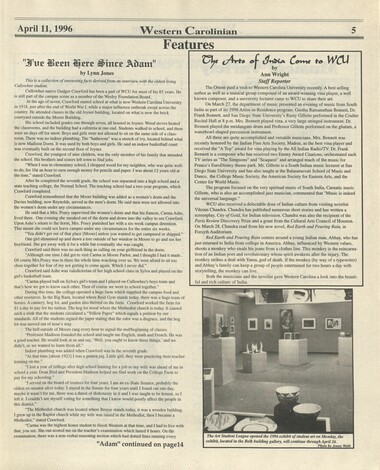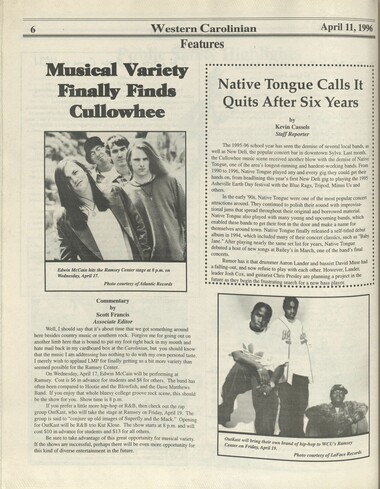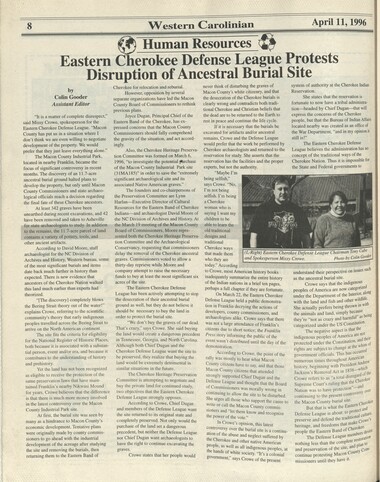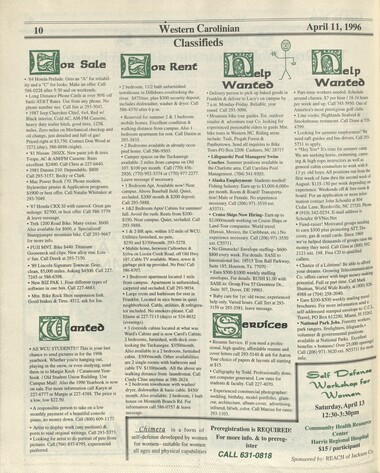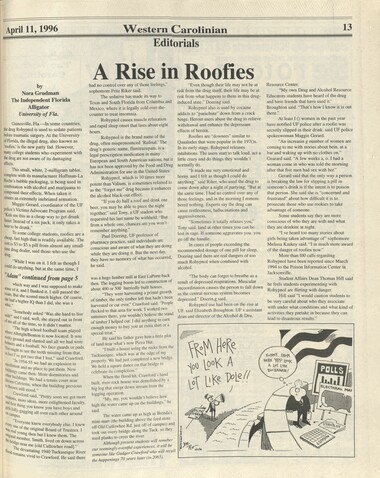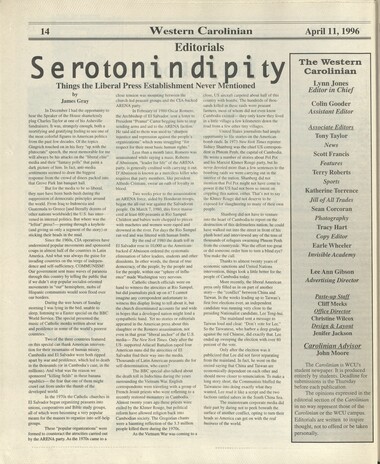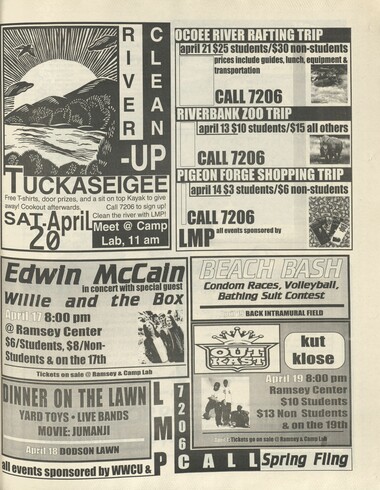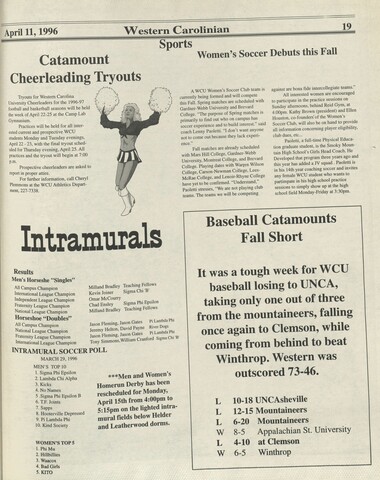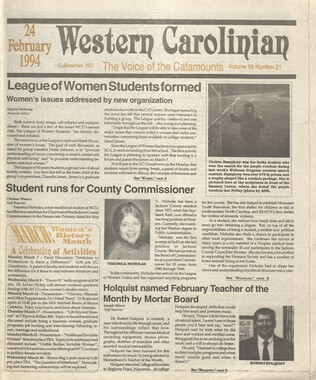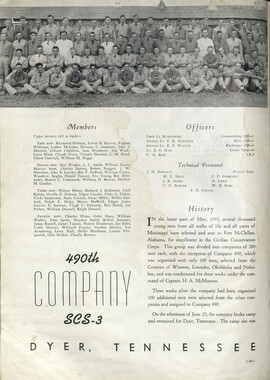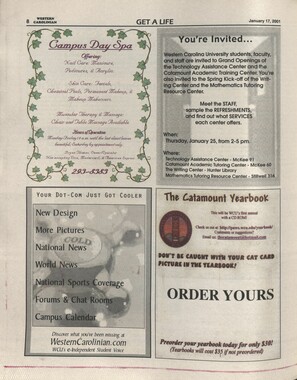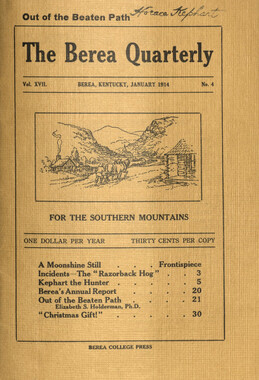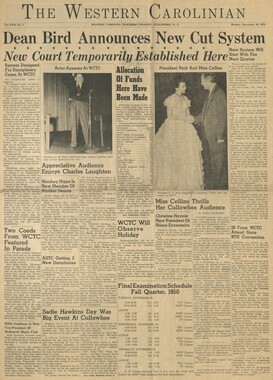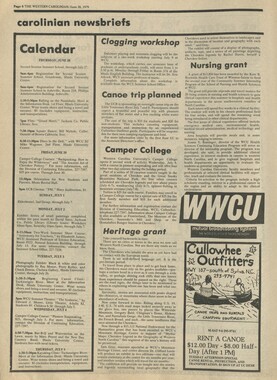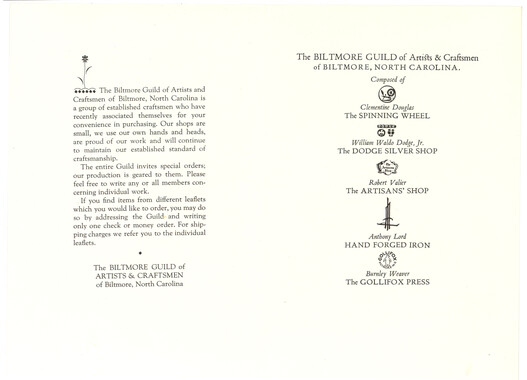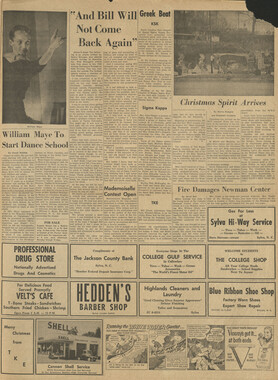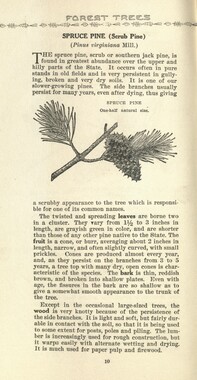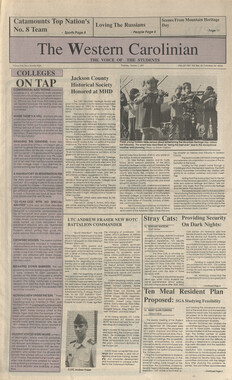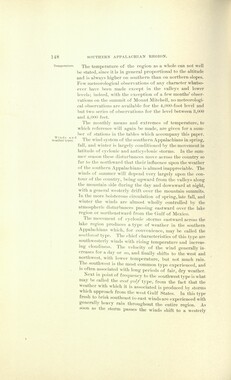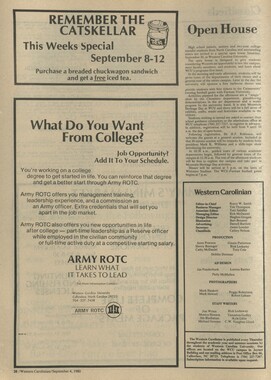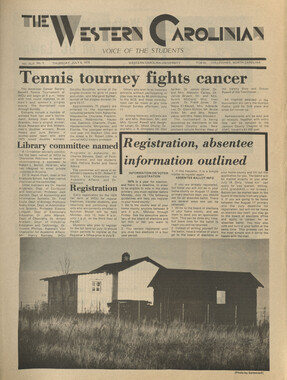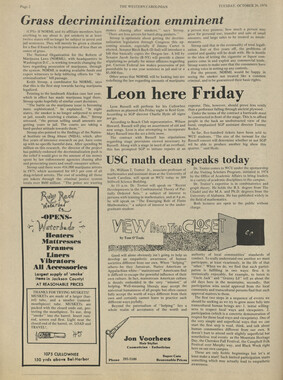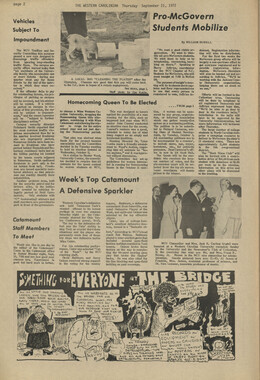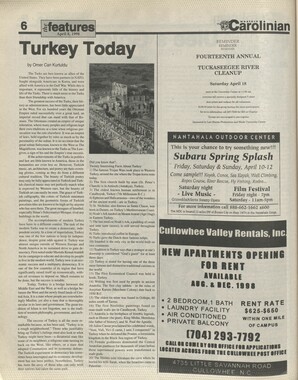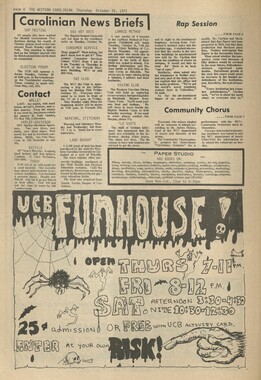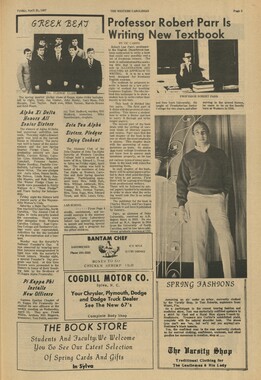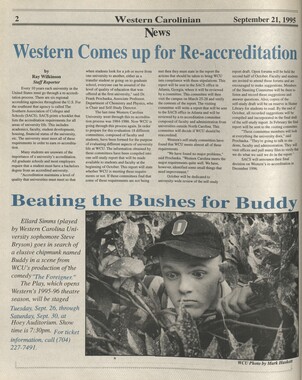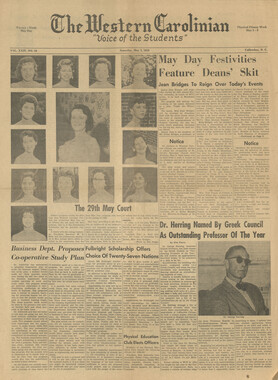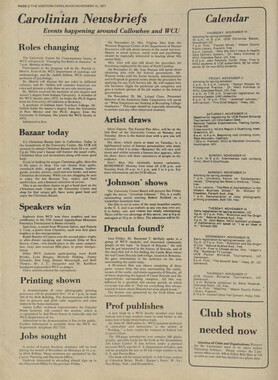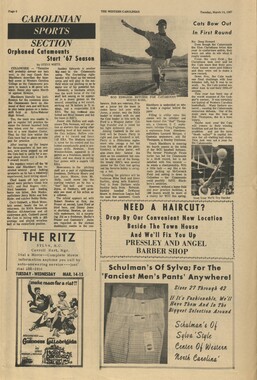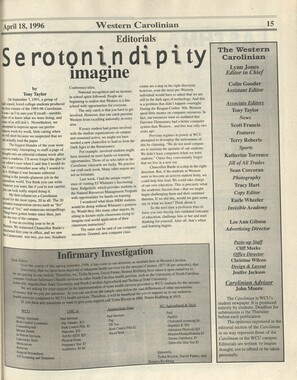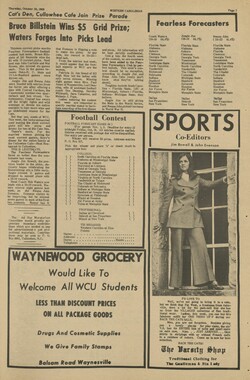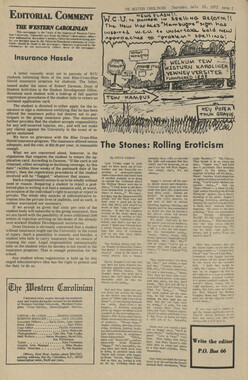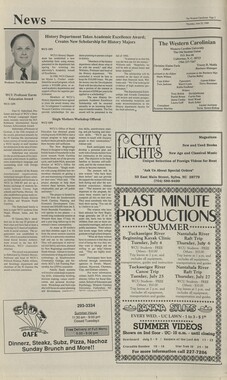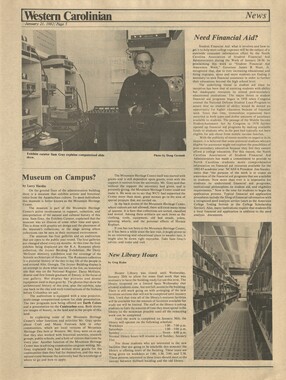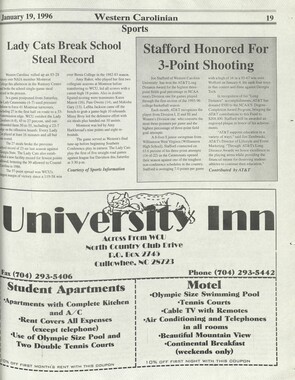Western Carolina University (20)
View all
- Canton Champion Fibre Company (2308)
- Cherokee Traditions (292)
- Civil War in Southern Appalachia (165)
- Craft Revival (1942)
- Great Smoky Mountains - A Park for America (2766)
- Highlights from Western Carolina University (430)
- Horace Kephart (941)
- Journeys Through Jackson (154)
- LGBTQIA+ Archive of Jackson County (85)
- Oral Histories of Western North Carolina (314)
- Picturing Appalachia (6772)
- Stories of Mountain Folk (413)
- Travel Western North Carolina (160)
- Western Carolina University Fine Art Museum Vitreograph Collection (129)
- Western Carolina University Herbarium (92)
- Western Carolina University: Making Memories (708)
- Western Carolina University Publications (2283)
- Western Carolina University Restricted Electronic Theses and Dissertations (146)
- Western North Carolina Regional Maps (71)
- World War II in Southern Appalachia (131)
University of North Carolina Asheville (6)
View all
- Western Carolina College (199)
- Western Carolina Teachers College (239)
- Western Carolina University (1792)
- Allanstand Cottage Industries (0)
- Appalachian National Park Association (0)
- Bennett, Kelly, 1890-1974 (0)
- Berry, Walter (0)
- Brasstown Carvers (0)
- Cain, Doreyl Ammons (0)
- Carver, George Washington, 1864?-1943 (0)
- Cathey, Joseph, 1803-1874 (0)
- Champion Fibre Company (0)
- Champion Paper and Fibre Company (0)
- Cherokee Indian Fair Association (0)
- Cherokee Language Program (0)
- Crittenden, Lorraine (0)
- Crowe, Amanda (0)
- Edmonston, Thomas Benton, 1842-1907 (0)
- Ensley, A. L. (Abraham Lincoln), 1865-1948 (0)
- Fromer, Irving Rhodes, 1913-1994 (0)
- George Butz (BFS 1907) (0)
- Goodrich, Frances Louisa (0)
- Grant, George Alexander, 1891-1964 (0)
- Heard, Marian Gladys (0)
- Kephart, Calvin, 1883-1969 (0)
- Kephart, Horace, 1862-1931 (0)
- Kephart, Laura, 1862-1954 (0)
- Laney, Gideon Thomas, 1889-1976 (0)
- Masa, George, 1881-1933 (0)
- McElhinney, William Julian, 1896-1953 (0)
- Niggli, Josephina, 1910-1983 (0)
- North Carolina Park Commission (0)
- Osborne, Kezia Stradley (0)
- Owens, Samuel Robert, 1918-1995 (0)
- Penland Weavers and Potters (0)
- Rhodes, Judy (0)
- Roberts, Vivienne (0)
- Roth, Albert, 1890-1974 (0)
- Schenck, Carl Alwin, 1868-1955 (0)
- Sherrill's Photography Studio (0)
- Smith, Edward Clark (0)
- Southern Highland Handicraft Guild (0)
- Southern Highlanders, Inc. (0)
- Stalcup, Jesse Bryson (0)
- Stearns, I. K. (0)
- Thompson, James Edward, 1880-1976 (0)
- United States. Indian Arts and Crafts Board (0)
- USFS (0)
- Vance, Zebulon Baird, 1830-1894 (0)
- Weaver, Zebulon, 1872-1948 (0)
- Western Carolina University. Mountain Heritage Center (0)
- Whitman, Walt, 1819-1892 (0)
- Wilburn, Hiram Coleman, 1880-1967 (0)
- Williams, Isadora (0)
- 1920s (57)
- 1930s (69)
- 1940s (114)
- 1950s (66)
- 1960s (314)
- 1970s (599)
- 1980s (406)
- 1990s (379)
- 2000s (195)
- 2010s (83)
- 1600s (0)
- 1700s (0)
- 1800s (0)
- 1810s (0)
- 1820s (0)
- 1830s (0)
- 1840s (0)
- 1850s (0)
- 1860s (0)
- 1870s (0)
- 1880s (0)
- 1890s (0)
- 1900s (0)
- 1910s (0)
- 2020s (0)
- Jackson County (N.C.) (2282)
- Appalachian Region, Southern (0)
- Asheville (N.C.) (0)
- Avery County (N.C.) (0)
- Blount County (Tenn.) (0)
- Buncombe County (N.C.) (0)
- Cherokee County (N.C.) (0)
- Clay County (N.C.) (0)
- Graham County (N.C.) (0)
- Great Smoky Mountains National Park (N.C. and Tenn.) (0)
- Haywood County (N.C.) (0)
- Henderson County (N.C.) (0)
- Knox County (Tenn.) (0)
- Knoxville (Tenn.) (0)
- Lake Santeetlah (N.C.) (0)
- Macon County (N.C.) (0)
- Madison County (N.C.) (0)
- McDowell County (N.C.) (0)
- Mitchell County (N.C.) (0)
- Polk County (N.C.) (0)
- Qualla Boundary (0)
- Rutherford County (N.C.) (0)
- Swain County (N.C.) (0)
- Transylvania County (N.C.) (0)
- Watauga County (N.C.) (0)
- Waynesville (N.C.) (0)
- Yancey County (N.C.) (0)
- Newsletters (510)
- Publications (documents) (1773)
- Aerial Photographs (0)
- Aerial Views (0)
- Albums (books) (0)
- Articles (0)
- Artifacts (object Genre) (0)
- Bibliographies (0)
- Biography (general Genre) (0)
- Cards (information Artifacts) (0)
- Clippings (information Artifacts) (0)
- Crafts (art Genres) (0)
- Depictions (visual Works) (0)
- Design Drawings (0)
- Drawings (visual Works) (0)
- Envelopes (0)
- Facsimiles (reproductions) (0)
- Fiction (general Genre) (0)
- Financial Records (0)
- Fliers (printed Matter) (0)
- Glass Plate Negatives (0)
- Guidebooks (0)
- Internegatives (0)
- Interviews (0)
- Land Surveys (0)
- Letters (correspondence) (0)
- Manuscripts (documents) (0)
- Maps (documents) (0)
- Memorandums (0)
- Minutes (administrative Records) (0)
- Negatives (photographs) (0)
- Newspapers (0)
- Occupation Currency (0)
- Paintings (visual Works) (0)
- Pen And Ink Drawings (0)
- Periodicals (0)
- Personal Narratives (0)
- Photographs (0)
- Plans (maps) (0)
- Poetry (0)
- Portraits (0)
- Postcards (0)
- Programs (documents) (0)
- Questionnaires (0)
- Scrapbooks (0)
- Sheet Music (0)
- Slides (photographs) (0)
- Songs (musical Compositions) (0)
- Sound Recordings (0)
- Specimens (0)
- Speeches (documents) (0)
- Text Messages (0)
- Tintypes (photographs) (0)
- Transcripts (0)
- Video Recordings (physical Artifacts) (0)
- Vitreographs (0)
- The Reporter, Western Carolina University (510)
- WCU Students Newspapers Collection (1744)
- A.L. Ensley Collection (0)
- Appalachian Industrial School Records (0)
- Appalachian National Park Association Records (0)
- Axley-Meroney Collection (0)
- Bayard Wootten Photograph Collection (0)
- Bethel Rural Community Organization Collection (0)
- Blumer Collection (0)
- C.W. Slagle Collection (0)
- Canton Area Historical Museum (0)
- Carlos C. Campbell Collection (0)
- Cataloochee History Project (0)
- Cherokee Studies Collection (0)
- Daisy Dame Photograph Album (0)
- Daniel Boone VI Collection (0)
- Doris Ulmann Photograph Collection (0)
- Elizabeth H. Lasley Collection (0)
- Elizabeth Woolworth Szold Fleharty Collection (0)
- Frank Fry Collection (0)
- George Masa Collection (0)
- Gideon Laney Collection (0)
- Hazel Scarborough Collection (0)
- Hiram C. Wilburn Papers (0)
- Historic Photographs Collection (0)
- Horace Kephart Collection (0)
- Humbard Collection (0)
- Hunter and Weaver Families Collection (0)
- I. D. Blumenthal Collection (0)
- Isadora Williams Collection (0)
- Jesse Bryson Stalcup Collection (0)
- Jim Thompson Collection (0)
- John B. Battle Collection (0)
- John C. Campbell Folk School Records (0)
- John Parris Collection (0)
- Judaculla Rock project (0)
- Kelly Bennett Collection (0)
- Love Family Papers (0)
- Major Wiley Parris Civil War Letters (0)
- Map Collection (0)
- McFee-Misemer Civil War Letters (0)
- Mountain Heritage Center Collection (0)
- Norburn - Robertson - Thomson Families Collection (0)
- Pauline Hood Collection (0)
- Pre-Guild Collection (0)
- Qualla Arts and Crafts Mutual Collection (0)
- R.A. Romanes Collection (0)
- Rosser H. Taylor Collection (0)
- Samuel Robert Owens Collection (0)
- Sara Madison Collection (0)
- Sherrill Studio Photo Collection (0)
- Smoky Mountains Hiking Club Collection (0)
- Stories of Mountain Folk - Radio Programs (0)
- Venoy and Elizabeth Reed Collection (0)
- WCU Gender and Sexuality Oral History Project (0)
- WCU Mountain Heritage Center Oral Histories (0)
- WCU Oral History Collection - Mountain People, Mountain Lives (0)
- Western North Carolina Tomorrow Black Oral History Project (0)
- William Williams Stringfield Collection (0)
- Zebulon Weaver Collection (0)
- College student newspapers and periodicals (1769)
- African Americans (0)
- Appalachian Trail (0)
- Artisans (0)
- Cherokee art (0)
- Cherokee artists -- North Carolina (0)
- Cherokee language (0)
- Cherokee pottery (0)
- Cherokee women (0)
- Church buildings (0)
- Civilian Conservation Corps (U.S.) (0)
- Dams (0)
- Dance (0)
- Education (0)
- Floods (0)
- Folk music (0)
- Forced removal, 1813-1903 (0)
- Forest conservation (0)
- Forests and forestry (0)
- Gender nonconformity (0)
- Great Smoky Mountains National Park (N.C. and Tenn.) (0)
- Hunting (0)
- Landscape photography (0)
- Logging (0)
- Maps (0)
- Mines and mineral resources (0)
- North Carolina -- Maps (0)
- Paper industry (0)
- Postcards (0)
- Pottery (0)
- Railroad trains (0)
- Rural electrification -- North Carolina, Western (0)
- School integration -- Southern States (0)
- Segregation -- North Carolina, Western (0)
- Slavery (0)
- Sports (0)
- Storytelling (0)
- Waterfalls -- Great Smoky Mountains (N.C. and Tenn.) (0)
- Weaving -- Appalachian Region, Southern (0)
- Wood-carving -- Appalachian Region, Southern (0)
- World War, 1939-1945 (0)
- Text (2283)
- MovingImage (0)
- Sound (0)
- StillImage (0)
Western Carolinian Volume 61 Number 21
Item
Item’s are ‘child’ level descriptions to ‘parent’ objects, (e.g. one page of a whole book).
-
-
April 11,1996 Western Carolinian Human Resources The Gray Wolf Reintroduced into Yellowstone by Adam Riggsbee Contributing Writer In North America alone, Canis lupus, or the gray wolf, once ranged from the Arctic Ocean to central Mexico, and from the Pacific coast to the Atlantic. The wolf's ability to adapt was incredible, but due to human society their range is now strictly limited. Canis lupus represents the top of the food chain in all ecosystems in which they are present, which may explain the reason for the human fear of wolves and their pack mentality. By the 1920s and '30s the wolf was exterminated throughout the lower 48 states in order to free land for the growing livestock industry, and because of the public's fear and ignorance. By the 1960s the only remaining populations in North America outside of Alaska and Canada were found in Minnesota on Isle Royale on Lake Superior, and in northern Mexico. This loss of a natural predator alarmed conservationists of the 1960s environmental movement, and programs were initiated that helped begin the gray wolf's recovery. In 1973 the Endangered Species Act (ESA) was passed and the gray wolf earned a place on the Endangered Species List in the lower 48 states. The ESA prohibits individuals from killing or otherwise taking endangered species and requires the US Fish and Wildlife Service to adopt plans for their recovery. The 2.2- million acre Yellowstone National Park is the largest US park outside of Alaska. The gray wolf was once the top predator of the Yellowstone ecosystem that actually includes the Grand Teton National Park, seven national forests, and other federal and state lands in three states totaling 14 million acres, not all of which is designated for wolf recovery. The reintroduction began on January 13, 1995. DEWS (Fish and Wildlife Service) officials captured twelve wolves from Alaska, releasing eight in Yellowstone, and the other four in Idaho in a secondary FWS reintroduction effort. The wolves were placed into one-acre holding pens for at least six weeks. Once the wolves were reintroduced FWS biologist began tracking the animals with radio collars to keep data on their progress, hunting habits and litter production. While the reintroduction is currently succeeding, there is still controversy. The conflict between conservationist and pastoralist continues. Ranchers in the sur- JPEND AJEMEJTER IN ANOTHER COUNTRY Stut>\ Abro3it> U Vour Ch*r\cc to Travel &nt> £Arn Crefcit Tow^rfcs Vour Vcgrcc M thc Same Time. for More Information About This Excitivig Opportvmitvf: ~ Get Information On-Line @ wvvw.sttidyabroad.com or www.Detersons.cooi Dick Cameron Student Development Office 460 HFR rounding areas have fears that wolves will leave the park's boundaries and prey on the local livestock. Many feared that conservationists would use the wolf as a political weapon to limit grazing ability, harvest timber and mining on federal land. Conservationists see the wolf s reintroduction as more valuable to the local ecosystem and the biosphere (the global ecosystem) by keeping elk, moose, and deer herds healthy and in check, resulting in less starving animals and disease among the herd. In 1988 the US Congress ordered a joint study between FWS and the National Parks Service (NPS) to determine how Canes lupus's reintroduction would effect Yellowstone in terms of the livestock, herd animals and the grizzly bear, a threatened species. In May of 1990 the report was released, stating that wolves would likely reduce elk numbers by only 10-20% and would have little or no effect on grizzly bears, but would probably reduce coyote numbers. Similar predictions were made for deer, moose, and bison, while little or no loss was seen for bighorn sheep and pronghorn. The report also stated that wolves were likely to follow elk and other prey in their winter migrations outside the park, but would kill only a small number of livestock. The FWS / NPS report acknowledged that the wolves would be (and are) currently designated as an "experimental-nonessential" animal giving property owners the right to protect their livestock if threatened. To cover losses of any livestock due to predation of the gray wolf, compensation funds will pay ranchers for proven wolf kills. The National Parks authorities commissioned an analysis released in 1992 of the economic effects of wolf recovery. Economists estimated the value of livestock wolves might kill in areas around the park, then projected the wolves' effect on big game animals and the revenue created by hunting such animals. After the reintroduction Yellowstone's bottom line will profit $18 million more the first year and about $110 million over the first 20 years. With the gray wolf reintroduction plan well underway, a new era has begun in the Yellowstone ecosystem. Conservationists are hoping that with successful reintroduction into Wyoming, maybe New Mexico will be next. Only time will tell if the gray wolf reintroduction will produce more harm than good. Conservationists believe the gray wolf represents a balance that the Yellowstone ecosystem has not had since its elimination in the 1920s and '30s. The reintroduction represents a chance to right some of the wrong. 18th Annual Bryan Adrian giUMMEfr Jerry Stackhouse (NBA) Dante Calabria (UNC) George Lynch (NBA) Drew Barry (Ga.Tech) FINALREGISTRATION Now Being Held For Boys and Girls, Ages 5-18. Call ANYTIME For A Free Brochure (704) 372-3236. Locations Include. Greensboro, N.C Charlotte. N.C. Raleigh. N.C. Banner Elk, N.C. Hickory. N.C. Gastonia. N.C. Mt. Olive. N.C. Concord. N.C. Elkin. N.C. Spartanburg, S.C Virginia Beach.V; ■kitititit The Bryan Adrian Basketball Camp is recognized as one of the finest teaching camps in the country.
Object
Object’s are ‘parent’ level descriptions to ‘children’ items, (e.g. a book with pages).
-
The Western Carolinian is Western Carolina University's student-run newspaper. The paper was published as the Cullowhee Yodel from 1924 to 1931 before changing its name to The Western Carolinian in 1933.
-
